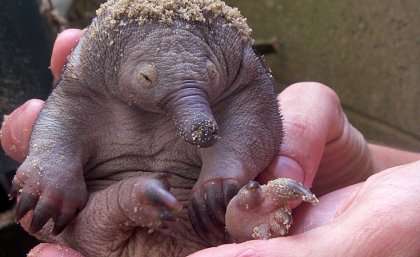Breeding study could save endangered long–beaked echidna

An echidna-breeding partnership between The University of Queensland and the Currumbin Wildlife Sanctuary has proved so successful that researchers hope their model could help save endangered echidna species.
UQ School of Agriculture and Food Sciences reproductive zoologist Associate Professor Stephen Johnston said the program had produced 14 short-beaked echidna puggles (babies) in the past five years, more than any other zoo in the world.
"Up to a few years ago it was thought almost impossible to breed echidnas in captivity, and most births were somewhat accidental and unplanned," Dr Johnston said.
"Now we can pretty much predict that, if we put A and B together and provide the right environmental conditions, a mating is likely to be successful.
"This breeding season our echidnas have already produced five eggs.
"We now have a better understanding of the echidna's temperature regulation requirements and we are seeking to identify what hormones are involved at different stages of the females' breeding cycle."
Dr Johnston said short-beaked echidnas like those born at Currumbin were relatively common in the wild in Australia, but time was running out for their larger cousins, the long-beaked echidnas.
Short-beaked echidnas are found in Australia and north-east New Guinea.
Their endangered long-beaked cousins are found in New Guinea and Indonesia, where they are hunted for food and prone to habitat fragmentation.
UQ and the Currumbin Wildlife Sanctuary plan to establish a research centre to increase knowledge of monotreme reproduction and biology.
Dr Johnston said echidnas had a "bizarre" method of reproduction.
"The male has a four-headed penis, and uses two of those heads at a time to ejaculate sperm," he said.
A female echidna typically has a 20-day gestation period before laying an egg directly into her temporary pouch that develops when she is pregnant and regresses when her baby no longer needs it.
The puggles hatch about 10 days after the egg is laid, and stay in the pouch for two to three months.
Dr Johnston said the research program aimed to perfect short-beaked echidna breeding and husbandry and understand the animals' physiology, behavior and relationships to reptiles and other mammals.
Currumbin Wildlife Sanctuary's general manager of life sciences, Michael Pyne, said the research was an exciting journey.
"It's so important now we use what we have learnt to make a real difference to conservation and the plight of the long-beaked echidna from Papua New Guinea," he said.
"Currumbin Wildlife Sanctuary is committed to conservation and research of our native wildlife and is proud to work closely with UQ in world-leading research such as this echidna project."
Provided by University of Queensland





















